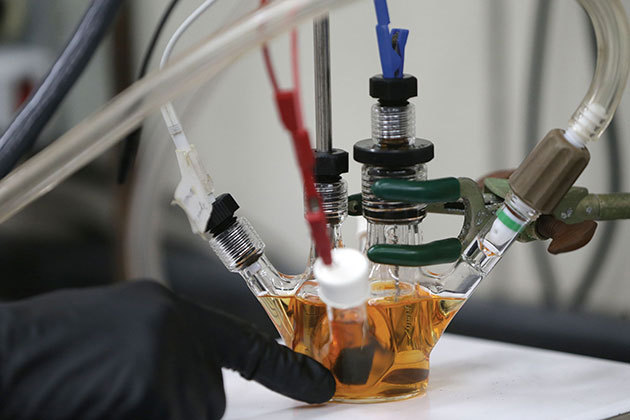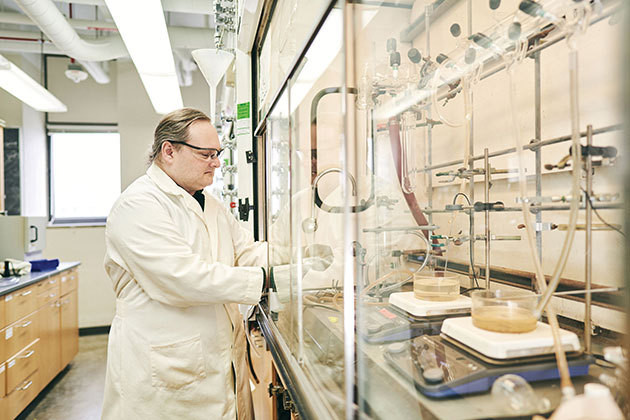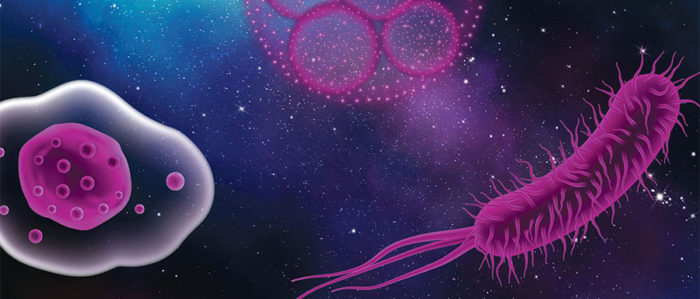This interview appeared in the Spring 2022 Letters & Science magazine.
John Berry is a transition metal chemist. That means he experiments with elements in “the big middle part of the periodic table” that are able to bond with one another in strange and interesting ways, producing electronic properties that can initiate new types of chemistry—including in the field of catalysis. That’s the area Berry’s been exploring, with Department of Energy funding. Now, through a novel catalytic process involving the oxidation of ammonia through bonds with a quirky element called “ruthenium,” Berry’s lab has discovered a way to spontaneously produce nitrogen. It’s incredibly exciting because no added energy is required, and the process can potentially be harnessed to produce electricity—cleanly. An important paper in Nature Chemistry, a patent from the Wisconsin Alumni Research Foundation (WARF), and funding from DoE are powering Berry and his students to work on fuel cells that could pave the way to a nitrogen-based fuel economy.
Congratulations! How does it feel to have a patent for work that could change the world?
I am extremely naïve about patents [laughs]. To be honest, after our paper was published, people have been crawling out of the woodwork to talk with me about this. There are several interesting applications being put forward. I think the most promising thing we will be able to develop is these fuel cell catalysts—where you have a fuel cell that runs off ammonia as a fuel, used to power all sorts of things, like automobiles. There is a huge impact to be made by switching from carbon-based fuels to nitrogen-based fuels. When you burn carbon-based fuels, carbon dioxide is a byproduct, and that’s a greenhouse gas. When you burn ammonia, you make nitrogen. That’s not a greenhouse gas — it’s already 80 percent of the atmosphere. There are actually a lot of efforts underway to modify internal combustion engines to efficiently use ammonia. Where this is really taking off is in the maritime shipping industry. There is a company in Australia that is putting an ammonia-powered boat on the water—a container ship. This shift to ammonia power is already in the wind.

But your team’s work goes further, in terms of not creating any noxious by-products.
Right. Running ammonia through internal combustion engines [as a container ship would do] can be a little dirty—they can’t oxidize the ammonia to 100% nitrogen without creating some nitrogen oxides that are not so great [for the environment]. Our process happens at an electrode, and because we have atomic control over how the catalyst operates, we get 100% selectivity for nitrogen. We wouldn’t be making greenhouse gases. We’d only be making N2. That’s the advantage of fuel cells over internal combustion engines. But it’s still a ways off.
How far off?
Well, my current student hopes to have measured a potential from a prototype fuel cell before he graduates. Hopefully within a year! But the discovery we made is more on the fundamental side. In my lab, for example, we need to retrain ourselves in all kinds of new areas. We’ve never built fuel cells before!
Where did this line of research start for you?
My PhD advisor at Texas A&M was a famous inorganic chemist named Al Cotton. He discovered the metal–metal multiple bond back in the 1960s. When you put two transition metals together, you get a lot of possibilities for what can happen electronically. When I came here 15 years ago, I wanted to apply what we know about metal–metal bonds to the field of catalysis — which is just a means of taking a chemical reaction and making it happen faster and more efficiently.
One thing we’ve been looking at in my lab is how multiple bonds form—for example, the ability of a metal to form a multiple bond to a non-metal element like nitrogen. Turns out nobody had really explored that before. When we started, it opened up a new direction in transition metal chemistry.
Why had nobody explored this before?
I don’t know! It’s interesting—we weren’t thinking too much about energy creation until we started thinking more deeply about ammonia and nitrogen. About seven years ago, I had a student who told me, “By the time I finish my PhD I want to have a patent.” I bit my tongue because I almost said, “You joined the wrong research group for that!” But he started all this chemistry, and now we have filed a patent with WARF.
Why might you have said “wrong group”?
My heart is in fundamental science. I’ve never really chased applications and I don’t have an entrepreneurial bone in my body. I knew there were inorganic chemists trying to make ammonia from nitrogen—ammonia is very important in agriculture—so I said, let’s do it the other way around. Instead of making ammonia from nitrogen, let’s try to get nitrogen from ammonia. Maybe, by doing it backwards, we could learn something new. My student got started on the idea of using the metal–metal multiple-bonded compounds to bind ammonia. We had the idea that we could potentially remove hydrogen atoms and electrons one at a time from the ammonia and turn it into nitrogen.
The Department of Energy funded a grant for us to start working on this effort as a way to discover more about ammonia synthesis, even though we took a “backwards” approach to it.

And so, from doing something “backwards” to see what might happen, you made a discovery that could change the carbon economy.
We go where the science takes us. I think it’s really important to have people motivated by potential applications. But I think it’s equally important to have people who are willing to do things just because they’ve never been done before. We thought we would need to input energy to make nitrogen from ammonia. What we discovered was that we didn’t need to do that at all. As soon as you add ammonia to our catalyst compound, it spontaneously makes nitrogen. Something like that had never been seen before.
And ruthenium was used for the catalyst? What can you tell us about it?
I’ve had this fascination with ruthenium for a long time. It’s an element with a notoriously difficult chemistry. “The chemistry of ruthenium is chemistry for connoisseurs!” is a statement attributed to Nobel laureate Sir Geoffrey Wilkinson, the PhD advisor of my PhD advisor. It’s not for everyone. But that’s what attracts me. I don’t like to work on easy problems [laughs]. If an element has a track record of being difficult, that’s the element for me!
There’s just one fly in the ointment, and it’s ammonia, right?
Yes. The ammonia synthesis industry, which operates on an absolutely massive scale worldwide, talks about different “colors” of ammonia: brown, gray, turquoise, blue, green. Nitrogen plus hydrogen equals ammonia. In principle, there’s no carbon necessary. Except that right now our best source of hydrogen is natural gas, a fossil fuel. Ammonia created using natural gas is called “gray” ammonia. The efforts to sequester the carbon from this process give what is called “blue” ammonia. But of course, everyone wants to get to “green” ammonia. If you can use a solar panel and a catalyst that splits water into oxygen and hydrogen, and feed the hydrogen into an ammonia synthesis plant—that whole process doesn’t have any carbon in it.
The potential is there!



